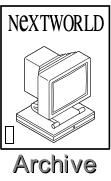 |  |  |  |  |  |  |
| | | | |

|

|
|
| |
May 1992 |
|
 |
|

|
 |
NeXT helping disabled
by Paul Karon
Northridge, CA: A small group of NeXT employees has been working without official company recognition to bring computers within reach of disabled people who have traditionally been locked out of personal computing.
NeXT attended the mid-March conference here on Technology and Persons with Disabilities, sponsored by the Office of Disabled Student Services at California State University Northridge. It was NeXT's third year at the conference, and the company's highest profile yet at the annual conference. "It's all volunteerism," said Max Henry, vice president and general manager of Pacific operations at NeXT.
"It shows the kind of people at NeXT, even though we're a small start-up, people volunteer to make the time to learn about this cause," said Henry, who has personally pushed to improve accessibility of NeXT machines.
A number of issues must be addressed if a computer system is to be fully accessible, said Brent Lochen, a systems programmer at NeXT who works with Henry on accessibility issues. "We're trying to get the right hooks into the operating system for developers to work on these issues," he said.
For example, some users are unable to type, or use a standard mouse, and so require an alternative input device, he explained. A sight-impaired computer user may have no difficulty typing, but would need some method, probably voice-activated, for ascertaining which applications or windows are currently active.
Using such input devices as the HeadMaster, a pointing device developed by Prentke Romich that is worn as a headset, users who cannot manipulate a conventional mouse can use the point-and-click technology fundamental to NeXT software.
One prototype system shown at the conference was developed by Cathy Haas, a lecturer at Stanford University in Palo Alto, California. Haas, who is hearing-impaired, teaches sign language. With Lochen's help, she has developed a NeXT-based system for teaching sign language. The system integrates images from a video camera with text and other inputs for display in various windows on a NeXT monitor.
Haas previously had developed a Macintosh-based system, but said the NeXT platform proved to be superior.
"The resolution of the computer is excellent," said Haas. Students can follow the examples of sign language, replay them as many times as desired, and at any speed. "The video is very fast, and it's easy to change the speed."
|
|